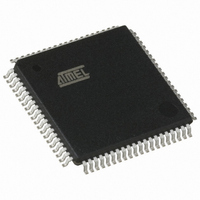AT89C5132-ROTUL Atmel, AT89C5132-ROTUL Datasheet - Page 131

AT89C5132-ROTUL
Manufacturer Part Number
AT89C5132-ROTUL
Description
IC 8051 MCU FLASH 64K USB 80TQFP
Manufacturer
Atmel
Series
AT89C513xr
Specifications of AT89C5132-ROTUL
Core Processor
C52X2
Core Size
8-Bit
Speed
20MHz
Connectivity
IDE/ATAPI, I²C, MMC, PCM, SPI, UART/USART, USB
Peripherals
I²S, POR, WDT
Number Of I /o
44
Program Memory Size
64KB (64K x 8)
Program Memory Type
FLASH
Eeprom Size
4K x 8
Ram Size
2.25K x 8
Voltage - Supply (vcc/vdd)
2.7 V ~ 3.3 V
Data Converters
A/D 2x10b
Oscillator Type
Internal
Operating Temperature
-40°C ~ 85°C
Package / Case
80-TQFP, 80-VQFP
Cpu Family
89C
Device Core
8051
Device Core Size
8b
Frequency (max)
40MHz
Interface Type
IDE/SPI/UART/USB
Total Internal Ram Size
2.25KB
# I/os (max)
44
Number Of Timers - General Purpose
2
Operating Supply Voltage (typ)
3V
Operating Supply Voltage (max)
3.3V
Operating Supply Voltage (min)
2.7V
On-chip Adc
2-chx10-bit
Instruction Set Architecture
CISC
Operating Temp Range
-40C to 85C
Operating Temperature Classification
Industrial
Mounting
Surface Mount
Pin Count
80
Package Type
TQFP
Package
80TQFP
Family Name
89C
Maximum Speed
40 MHz
Operating Supply Voltage
3 V
Data Bus Width
8 Bit
Number Of Programmable I/os
44
Number Of Timers
2
Maximum Clock Frequency
20 MHz
Data Ram Size
2304 B
Mounting Style
SMD/SMT
A/d Bit Size
10 bit
A/d Channels Available
2
Height
1.45 mm
Length
14.1 mm
Maximum Operating Temperature
+ 85 C
Minimum Operating Temperature
- 40 C
Supply Voltage (max)
3.3 V
Supply Voltage (min)
2.7 V
Width
14.1 mm
For Use With
AT89OCD-01 - USB EMULATOR FOR AT8XC51 MCU
Lead Free Status / RoHS Status
Lead free / RoHS Compliant
Available stocks
Company
Part Number
Manufacturer
Quantity
Price
20. Two-wire Interface (TWI) Controller
20.1
4173E–USB–09/07
Description
The AT89C5132 implements a TWI controller supporting the four standard master and slave
modes with multimaster capability. Thus, it allows connection of slave devices like LCD control-
ler, audio DAC, etc., but also external master controlling where the AT89C5132 is used as a
peripheral of a host.
The TWI bus is a bi-directional TWI serial communication standard. It is designed primarily for
simple but efficient integrated circuit control. The system is comprised of 2 lines, SCL (Serial
Clock) and SDA (Serial Data) that carry information between the ICs connected to them. The
serial data transfer is limited to 100 Kbit/s in low speed mode, however, some higher bit rates
can be achieved depending on the oscillator frequency. Various communication configurations
can be designed using this bus. Figure 20-1 shows a typical TWI bus configuration using the
AT89C5132 in master and slave modes. All the devices connected to the bus can be master and
slave.
Figure 20-1. Typical TWI Bus Configuration
The CPU interfaces to the TWI logic via the following four 8-bit special function registers: the
Synchronous Serial Control register (SSCON SFR, see Table 26), the Synchronous Serial Data
register (SSDAT SFR, see Table 28), the Synchronous Serial Status register (SSSTA SFR, see
Table 27) and the Synchronous Serial Address register (SSADR SFR, see Table 29).
SSCON is used to enable the controller, to program the bit rate (see Table 26), to enable slave
modes, to acknowledge or not a received data, to send a START or a STOP condition on the
TWI bus, and to acknowledge a serial interrupt. A hardware reset disables the TWI controller.
SSSTA contains a status code which reflects the status of the TWI logic and the TWI bus. The
three least significant bits are always zero. The five most significant bits contains the status
code. There are 26 possible status codes. When SSSTA contains F8h, no relevant state infor-
mation is available and no serial interrupt is requested. A valid status code is available in SSSTA
after SSI is set by hardware and is still present until SSI has been reset by software. Table 20 to
Table 20-6 give the status for both master and slave modes and miscellaneous states.
SSDAT contains a Byte of serial data to be transmitted or a Byte which has just been received. It
is addressable while it is not in process of shifting a Byte. This occurs when TWI logic is in a
defined state and the serial interrupt flag is set. Data in SSDAT remains stable as long as SSI is
set. While data is being shifted out, data on the bus is simultaneously shifted in; SSDAT always
contains the last Byte present on the bus.
SSADR may be loaded with the 7 - bit slave address (7 most significant bits) to which the con-
troller will respond when programmed as a slave transmitter or receiver. The LSB is used to
enable general call address (00h) recognition.
Figure 20-2 shows how a data transfer is accomplished on the TWI bus.
Master/Slave
AT89C5132
P1.7/SDA
P1.6/SCL
Rp
Rp
Display
LCD
Audio
DAC
AT89C5132
SCL
SDA
Microprocessor
HOST
131














